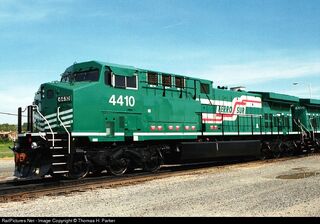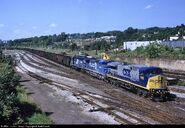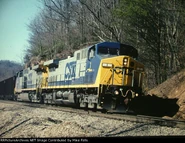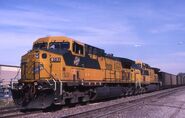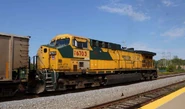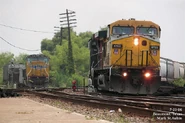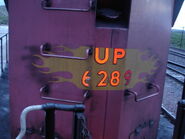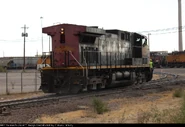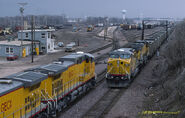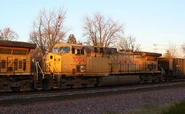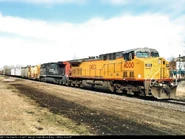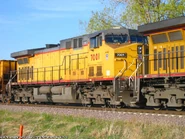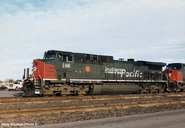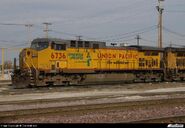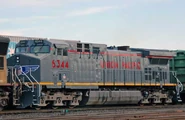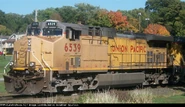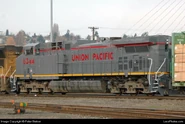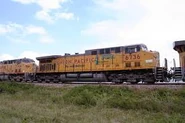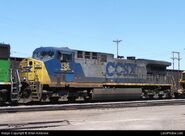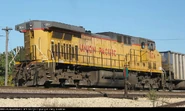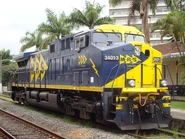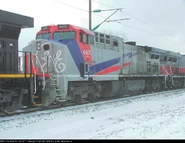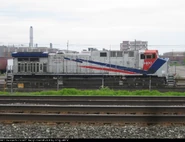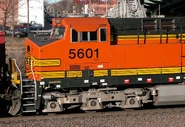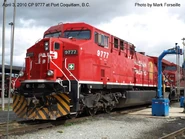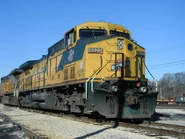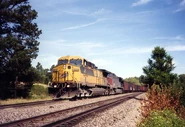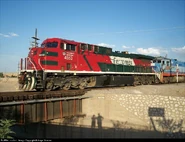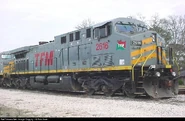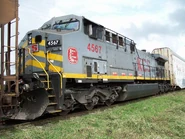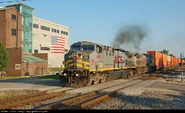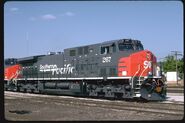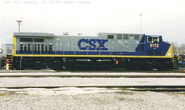Bio[]
The GE (General Electric) AC4400CW is a high-powered six-axle, AC-traction 4,400hp diesel locomotive built from 1994 to 2004 (first introduced in 1993).
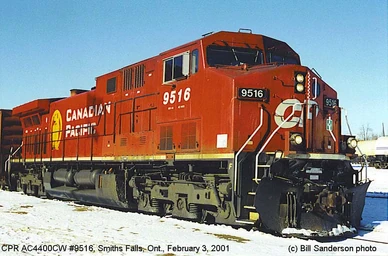
An example of an early CP (Canadian Pacific) 'hi-aid' trucked AC4400CW.
The model was one of the very first high-powered, single-engined, AC-traction diesel locomotives produced by GE, as well as being one of the very first major types of commercially successful North American AC-traction diesel locomotives ever built (besides the EMD SD70MAC; its rival).
Various American, Mexican, and Canadian Class 1 railroads or systems such as the Union Pacific (UP) Southern Pacific (SP), CSX Transportation (CSXT), Canadian Pacific (CP), and the Chicago And Northwestern (CNW) were the original customers, while Ferromex (FXE) and numerous Mexican Class 2 railways, railroads, or systems in Mexico (such as Ferrosur) and throughout the rest of the Latin American region purchased the model because of its reliability and revolutionary technology; especially in regards to its successful AC-traction performance for the model has been proven to be far more than capable of hauling long and heavy trains up steep grades or slopes with ease when compared to a set of traditional DC-traction models like the SD40-2. Companies such as BNSF, CEFX, Kansas City Southern (KCS) and their affiliate TFM (KCSM) were the later customers.
Many have been built (close to about 3,000), and are still currently in service with various railways and/or railroads throughout North America, as well as various places in South America and Australia.
A South American, or Latin American variant exists as well: the AC44CWi (or simply AC44i), and has been in production since 2007-2008 for MRS Logística.
Only a handful have been retired to serve in lease service with CEFX (primarily from the CP). CP #8644 was the first of several AC4400CW units to be retired.
Despite having been replaced by the succeeding ES44AC in GE's catalog for domestic carriers in 2004-2005, foreign variants of the model (such as the AC44i) are still available for export as of 2007-2008. Though, in 2006, remote ore haulers Quebec Cartier Mining (QCMN) and Quebec North Shore & Labrador (QNS&L) of Canada took delivery of five units to aid their existing fleets.
History[]
The AC4400CW is essentially the AC-traction version of a C44-9W "Dash 9", which is a type of traditional
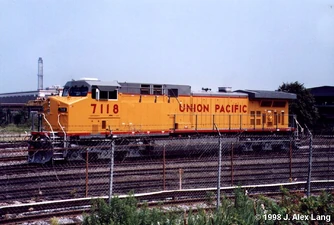
UP #7118 fresh from Erie, PA (note the large distinct radiator cabinet or "box" on the side which is used for housing the AC inverters and other equipment).
DC-traction diesel locomotive. Yet what makes it far more significant than its DC-traction counter-part, is the model being the first AC-traction diesel locomotive built by GE. Although two steps behind the competition, GE quickly revitalized the concept of AC-traction technology by introducing a much more simplistic method of inverting the DC current fed to the traction motors through the use of individual invertor banks per traction motor as opposed to one per truck like EMD. Their design further allowed individual traction motors to be cut out in the event of problems, whereas EMD locomotives had to have the entire truck cut out in order to isolate the problem of a traction motor. Invertor banks, each of which consists of six GTO's (Gated Turn On devices) or, starting in early 1998, IGBT's (Integrated Gate Bipolar Transistors), "chop" DC power from the main alternator/rectifier to produce three-phase AC power, which is then delivered to the traction motors. Erie's decision to incorporate one invertor per traction motor gives older GE AC-traction models a massive wall of 36 GTO's in six invertor banks contained in the distinctive box mounted on the left-side of the cab (known as an "Auxiliary Cab" in GE context). Newer AC4400CW units equipped with IGBT technology have an essentially empty box, in contrast to earlier units built prior. Said method(s) developed by the design engineers at GE helped relieve stress from railroad maintenance crews. The AC4400CW was also the first GE model to feature a far more advanced microprocessor control system (better than what was previously offered or featured with the Dash 8 and Dash 9), which furthermore made it part of its own independent line as opposed to being part of the Dash 9 line at the time.
The AC4400CW was first built and demonstrated in 1994 and further succeeded in dominating over the EMD SD70MAC in sales and popularity a year later, to which the AC4400CW was built to compete with. EMD's SD70MAC was one of the very first commercially-successful AC-traction diesel locomotive models built in North America. Hence, the AC4400CW being a direct response to the rival model. Thus, GE furthermore created their own type of revolutionary AC-traction diesel locomotive model, and began to dominate over their competition even more-so than before. The model was originally intended for use in heavy-haul applications, and was built to serve CSX Transportation's heavy duty coal drag service throughout the Appalachian Mountains between West Virginia, Pennsylvania, and the rest of the East, while also serving the Chicago And Northwestern (CNW) and Union Pacific's (UP) coal drag service on their rather long and heavy coal trains across Wyoming in the Powder River Basin region out West. Though originally intended and used for such purpose, both railroads (even during the time of the merger between the UP and CNW in 1995) eventually utilized their fleets of so-called "pigs" on other slow-moving general merchandise freight or manifest trains as with how CP, CSX, and other owners currently utilize their units as of today. Further making the AC4400CW more of a "pig" (or "mule") than a "horse" (as referred to by enthusiasts and locomotive experts), considering that AC4400CW units were intended for slow "pig" or "mule" service as opposed to high-speed "horse" service.
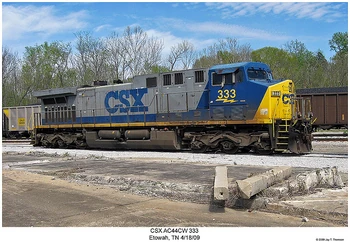
A CSX AC4400CW with added 'lightning bolts' (note the self-steering "AC-truck" variant).
The AC4400CW was also one of the first diesel locomotives built by GE to be equipped with optional radial self-steering "steerable trucks" (which were once briefly offered with the AC4400CW's DC-traction counter-part in lieu of the EMD HTCR radial truck), and to be capable of providing "distributed power" to serve as a "distributed power unit" (DPU); which is a method consisting of multiple locomotive sets (or individual units) placed on different parts of a train to be controlled by the engineer of a leading locomotive simultaneously via radio signals sent through the use of the on-board computer system without the need of having manned helper sets: multiple crews operating multiple locomotive sets at different speeds, or have the throttle positioned at different notches on different parts of said train. The locomotive model also included locomotive management software such as "controlled tractive effort" (CTE), which helped provide better tractive effort or improved wheel adhesion for whenever a wheelslip were to occur; similar to what was originally included with the SD70MAC and with subsequent "Phase 2" and "Phase 3" versions of the SD70M, as well as later Dash 9 units. Although DPU and CTE technology proved to be reliable on earlier AC4400CW units, the CTE technology had a tendency to fail, further causing wheel or rail wear, as well as overloaded axles (resulting in more severe wheelslip). Thus, a new type of truck or bogey was developed later-on during production to rectify said issues: the "AC" radial truck, providing even better tractive effort than before in contrast to GE's "hi-aid" (or "hi-AD") truck. Yet, upon its completion and successful demonstrations, the truck style proved to be only popular with customers such as CSX, Ferromex (FXE), and CP Rail (Canadian Pacific); who were ironically some of the several customers to order both styles, versions, or variants of trucks for their subsequent AC4400CW fleets. Despite having been offered with the Dash 9, the overall truck design, variant, or model proved to be unpopular with said model, in spite of the comments addressed by customers whom preferred the EMD HTCR/HTCR-II truck and encouraged GE to follow suit by offering a similar design for their locomotives.
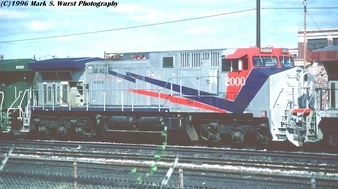
The AC4400CW prototype after having been renumbered from GECX #4400. Dash 9 and AC6000CW demonstrators are coupled on either side of the unit and can be seen in the image as well.
Although not the first to serve in general revenue service, CSX #9100-9102 were the first production units to emerge from GE's Erie facility in June 1994. As a result of a derailment on GE's test track, the delivery of the units was post-poned. Meanwhile, units #9103-9113 were assembled months later, and despite having only less than two weeks in service after delivery, they were renumbered to CSX #4-14. CSX #9100-9103 followed suit, and were renumbered #1-3 as well as receiving distinct "lighning bolt" decals beneath their numbers which became standard on all AC-traction units (minus some exceptions).
BN (Burlington Northern) tested several AC4400CW units leased from CSX in late-1995 to compare and contrast performances with their existing SD70MAC fleet. Such move was made from GE as an offer to attract BN as a customer, though it wasn't until towards the early-2000's (after numerous test runs with their three demonstrators) until successor BNSF purchased a fleet of 150 units (despite utilizing said fleet for spare use). The SD70MAC was furthermore chosen over the AC4400CW by Burlington Northern due to the SD70MAC being the preferred choice for the railroad because it had a better performance when relating to the CTE features and capabilities offered with both models (besides EMD also having more successful demonstrations with the BN and better contracts as a result of the SD60MAC experiment). In other words, the AC4400CW lacked what the SD70MAC included at the time: flawless CTE technology and/or radial self-steering trucks (which was under development, but wasn't finalized until CSX began placing orders on their next batches of units delivered sometime from 1997-2001).
Many are still currently in revenue service, though several have been scrapped as a result of being involved in numerous wrecks. It's initial success further led to the development of the AC6000CW, and also inspired the development for such models as the ES44AC: its initial replacement.
Moar of these head to #erman daily as they are falling apart.
Teething Issues[]
Like its initial counter-part, the AC4400CW suffered numerous mechanical issues with its intercooling system later-on into production. Yet, the problems were soon rectified.
Confusion[]
When identifying the locomotive model, the typical GE classification concept for diesel locomotive models is listed as follows:
- "AC" for "AC-traction" (or for the "AC" line in some context).
- "4400" referring to the 4,400 horsepower rating.
- "C" meaning "C-C", "Co-Co", or "six-axle".
- "W" meaning "wide-cab" or "American Safety Cab".
Spotting Features[]
The AC4400CW shouldn't be confused with its DC predecessor (C44-9W or the "Dash 9"). Numerous spotting differences or distinguishing characteristics are known to help identify the model apart from its externally-similar counter-parts.
- One notable difference is the style of trucks or bogies.
- Another difference is the presence of a large radiator cabinet (used for housing the locomotive's AC-invertor components) is placed on one side of the locomotive dubbing its "wide-cab" as an "Auxiliary Cab" (or "Aux Cab").

Brand-new Ferrosur (a subsidiary of Ferromex) AC4400CW units.
- Another notable difference, is the fact that some US Class 1 railroads (notably UP and CSX), often paint lightning bolts on the sides of the cab or along the carbody to distinguish the model from their existing DC-traction models. Though, UP has since discontinued said concept since 2001.
- AC4400CW units with the distinguished 'AC trucks' are often referred to as the AH4400CW or CW44AH (by CSX) as a result of being "heavier" (built to similar specs as the ES44AH) or weighing more than the preceding units.
- AC44ACCTE, AC4400CWCTE, AC45ACCTE (the "5" meaning the truck length)' AC44CCTE, AC44CWCTE, AC4400CCTE, C44AC-CTE or the C44CCTE are either alternate designations, units equipped with updated/upgraded electronics, or units retrofitted with features previously not included.
- Other designations include: C44AC, CW44AC, AC44W, or AC44CW.
- The "CCTE" ("C-C" and/or "Controlled Tractive Effort") suffix commonly refers to units owned by the UP which have updated/upgraded CTE software for its on-board microcomputer.
- UP's AC4400CW fleet is numbered from 5554-6164 (6165 being an non-renumbered SD60M) to 6166-6895, to 6969-7009, and from 7080-7297.
- Later, post-production AC4400CW units received by the UP (units delivered with the "American flag" scheme from around 2003-2004; not including the repainted units or units delivered prior) are often classified as an "AC45ACCTE", "AC44CW-CTE", or similar (as listed above), primarily due to having updated electronics, software, and control systems which were eventually implemented on their current C45ACCTE (ES44AC) fleet. The vast majority of preceding units (not delivered in said scheme variant) have also been upgraded with said features as well.
- The SP's AC4400CW fleet had the "SP" initials pressed closer together rather than having them spaced further apart like their subsequent Dash 9's. They were also numbered in triple digits as opposed to four (SP #100-378).
Specifications[]
| Model | AC4400CW |
|---|---|
| Production Dates | 1995 to 2004 and from 2007-2008 to present |
| Total Built | Approx. 3,000* |
| Length | 73' 2" |
| Wheel Arrangement | C-C |
| Engine | 7FDL-16 |
| Horsepower | 4,400hp |
| Alternator |
GMG196/GMG192 |
| Traction Motors | GEB13 |
| Weight x 1,000 lbs. | 408-432 |
Note*: Still available for export sales.
Production Roster[]
| Owner | Road Number(s) | Quantity | Build Dates |
|---|---|---|---|
| Burlington Northern Santa Fe (BNSF) | 5600-5717, 5838-5840 | 121 | 1999-2004 |
| Canadian Pacific (CP; CP Rail) | 8500-8580, 8600-8655, 9500-9683, 9700-9740, 9750-9784, 9800-9840 | 438 | 1995-2004 |
| Carbones del Cerrejón (Columbia) | 1014 | 1 | 2006 |
| Chicago and Northwestern (CNW) | 8801-8835 | 35 | 1994 |
| CIT Group, Inc. (CEFX/CITX) | 1001-1059 | 59 | 2001-2004 |
| CSX Transportation (CSX; CSXT) | 15-173, 201-599, 5101-5122, 9100-9113 | 594 | 1994-2002 |
| Ferromex (FXE; Mexico) | 4500-4574 | 75 | 1999-2004 |
| Ferrominera del Orinoco (Venezuela) | 1058-1059 | 2 | 2004 |
| Ferrocarril del Sureste (Ferrosur; Mexico) | 4400-4437 | 38 | 2000-2004 |
| General Electric Corporation Leasing (GECX; test unit) | 2000, 4400 (unit renumbered in 1997)* | 1* | 1993 |
| General Electric Corporation Leasing (GECX) | 4000-4009* (back-order units delivered to UP) | 10* | 1997 |
| Kansas City Southern (KCS) | 2000-2049 | 50 | 1999 |
| Québec, North Shore & Labrador (QNSL) | 415-426 | 10 | 2005-2006 |
| Québec Cartier Mining Company | 11-29 | 19 | 2002-2007 |
| Southern Pacific (SP) | 100-378 | 279 | 1995 |
| Transportacion Ferroviaria Mexicana (Mexico) | 2600-2674 | 75 | 1998-2000 |
| Union Pacific (UP) | 5554-5694, 5700-6081, 5711-5748 (2nd), 6430-6699, 6738-6887, 6995-7297, 9997-9999 | 1,287 | 1994-2004 |
Trivia/Facts[]
- The actual name of the locomotive is often pronounced as "AC forty-four thousand CW", "AC forty-four hundred CW" or simply "AC four-thousand four-hundred CW".
- CNW #8801 (now UP #6703) was the very first ever AC4400CW unit delivered to the CNW, and also received a special commemorative plaque regarding a deceased train operator from Bill, Wyoming (where most of the CNW's AC4400CW units originally operated and still do as of today). The unit has also received an unusual amount of patchwork in recent years.
- UP #6700 (formally 9997, the other two being 9998 and 9999) was the first of the three AC4400CW units delivered to the Union Pacific.
- The CP originally intended to replace their aging ALCO Century Series diesels with fleets of new, high-tech, AC4400CW units from GE in 1995 as a result of outliving their purpose, and the closure of MLW; furthermore making replacement parts for said diesels scarce.
- GE originally intended on having the AC4400CW to have completely different, less rugged appearance from the Dash 9, but decided not to as a result of design interference regarding the electronics.
- The AC4400CW prototype or testbed had "Dofasco" trucks before their existing "hi-AD" and AC-truck models were developed for the official production model, as well as having a Dash 8-style fuel tank. Oddly, the prototype was also built to ATSF specifications: having a notched cab roof and riding on a shorter wheelbase.
- CNW's fleet of AC4400CW units were the first to receive DPU and CTE technology, which weren't even included with the UP or SP's early orders until it caught on with the latter.
- The AC4400CW was also one of the last locomotive models ordered by the SP and CNW before the UP's acqusition of both respective railroads in 1995 and 1996, besides also being one of the only diesel locomotive models owned by either railroad to be AC-traction.
- Most of Union Pacific's AC4400CW units within their fleet are actually former SP and CNW units acquired from their respective mergers.
- The majority of AC4400CW's owned by the CNW sponsored the Operation Lifesaver campaign.
- AVWR numbers 767 and 777 were two CP AC4400CW's leased and used for the fictional "Unstoppable" film back in 2009/2010 (as of late-2010, the units still wear the stripes applied to the front plows of the units). Two more were soon leased, and used for stunt purposes, while artificial cabs were constructed for up-close shots, reference material, and for stunt scenes.
- Oddly, UP #6289 (a former SP AC4400CW) was patched with a flame-style decal as opposed to the usual patchwork.
- SP #146 (before the merger) had the SP's original "Daylight" logo applied on the side of it's radiator cabinet cover.
- Several numerous GECX (General Electric Company Leasing) AC4400CW demonstrator units were actually painted in UP primer livery in 1997 before eventually becoming part of a back-order later fulfilled from the railroad (one in particular; #7001, still retains its primer livery as of early-2013).
- Ironically, the very first CNW unit to be repainted and renumbered into the UP was actually involved in a serious wreck during a head-on collision on a blind curve on the UP's Donner Pass route in Northern California sometime during 1997-1998; nearly completely destroying the locomotive. Thankfully, the unit was salvageable and has since been rebuilt back to its original shape.
- CSX #1 (now #173) "Spirit of West Virginia" originally didn't retain such banner, but eventually received it during an overhaul which resulted in the replacement of the original "hi-ad" trucks with the once-exclusive "AC trucks".
- Most SP AC4400CW units were fitted or equipped with a flashing or alternating ditch-light feature like with what CSX, NS, and Amtrak utilize on their active units. Today, however, most ex-SP AC44's currently have had them removed (such as the button being disconnected, plated-over, etc.), while some still retain them and are fully functioning; albeit rare usage from crews.
- BNSF's fleet of AC4400CW's are currently used as spare units 121 locomotives for BNSF.
CSX #1 "Spirit of West Virginia" Gallery[]
CNW 8801 Gallery[]
Oddly-painted AC4400CW Units[]
AC4400CW General Gallery[]
Sources[]

CSX power struggle 2-24-2007
An AC4400CW and an SD70AC revealing wheelslip capabilities with their revolutionary truck designs and locomotive management software.
http://www.qstation.org/5600/bnsf5600.html
http://www.thedieselshop.us/UP.HTML
http://www.getransportation.com/railconnect360/locotrol-distributed-power-systems

